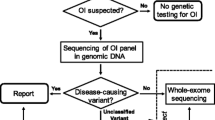Summary
Osteogenesis imperfecta is a rare hereditary disease mostly caused by mutations impairing collagen synthesis and modification. Recently recessive forms have been described influencing differentiation and activity of osteoblasts and osteoclasts. Most prominent signs are fractures due to low traumata and deformities of long bones and vertebrae. Additional patients can be affected by dwarfism, scoliosis Dentinogenesis imperfecta, deafness and a blueish discoloration of the sclera. During childhood state of the art medical treatment are i.v. bisphosphonates to increase bone mass and to reduce fracture rate. Surgical interventions are needed to treat fractures, to correct deformities and should always be accompanied by physiotherapeutic and rehabilitative interventions.
Zusammenfassung
Die Osteogenesis imperfecta ist eine seltene angeborene Erkrankung, welche in ~ 85% der Fälle auf Mutationen in den Kollagengenen COL1A1/A2 beruht. Folglich kommt es in den Osteoblasten zu einer veränderten Kollagensynthese und -modifikation. In den letzten Jahren ist es gelungen, die genetische Ursache für seltene rezessive Formen, welche nicht nur die Osteoblastenfunktion, sondern auch die Osteoklastenfunktion verändern, zu identifizieren. Das führende klinische Symptom ist die erhöhte Knochenfragilität im Rahmen niedrig-traumatischer Ereignisse und die Deformierung der langen Röhrenknochen. Zusätzlich können eine Dentinogenesis imperfecta, ein Kleinwuchs, eine Schwerhörigkeit und eine „Blau- bzw Grauverfärbung" der Skleren auftreten. Die Therapie basiert auf 3 Ansätzen: Während Kindheit und Jugend ist die intravenöse Gabe von Bisphosphonaten die medikamentöse Therapie der Wahl mit der best verfügbaren Evidenz. Chirurgische / orthopädische Interventionen sind notwendig zur Versorgung komplizierter Frakturen und der elektiven osteosynthetischen Begradigung im Falle schwerer Deformierungen der Extremitäten. Sowohl die medikamentöse Therapie als auch orthopädische Eingriffe sollten kontinuierlich von physiotherapeutischen Maßnahmen begleitet werden, um eine Kräftigung der Muskulatur als wichtigstem osteoanabolen Stimulus und eine langfristige Selbständigkeit der Betroffenen zu gewährleisten.




Similar content being viewed by others
References
Rauch F, Glorieux FH. Osteogenesis imperfecta. Lancet. 2004;363(9418):1377–85.
Schramm T, et al. Prenatal sonographic diagnosis of skeletal dysplasias. Ultrasound Obstet Gynecol. 2009;34(2):160–70.
Pontz BF, Stoss H, Spranger J. Heterogeneity in osteogenesis imperfecta: clinical and morphological findings. Ann N Y Acad Sci. 1988;543:30–9.
Anissipour AK, et al. Behavior of scoliosis during growth in children with osteogenesis imperfecta. J Bone Joint Surg Am. 2014;96(3):237–43.
Karbowski A, Schwitalle M, Eckardt A. [Scoliosis in patients with osteogenesis imperfecta: a federal nation-wide cross-sectional study]. Z Orthop Ihre Grenzgeb. 1999;137(3):219–22.
Kaiser-Kupfer MI, et al. Correlation of ocular rigidity and blue sclerae in osteogenesis imperfecta. Trans Ophthalmol Soc U K. 1985;104(Pt. 2):191–5.
Devaraju D, et al. Dentinogenesis imperfecta type I: a case report with literature review on nomenclature system. J Oral Maxillofac Pathol. 2014;18(Suppl. 1):131–4.
Marini JC, Blissett AR. New genes in bone development: whatʼs new in osteogenesis imperfecta. J Clin Endocrinol Metab. 2013;98:3095–103.
Semler O, et al. A mutation in the 5ʹ-UTR of IFITM5 creates an in-frame start codon and causes autosomal-dominant osteogenesis imperfecta type V with hyperplastic callus. Am J Hum Genet. 2012;91(2):349–57.
Cho TJ, et al. A single recurrent mutation in the 5ʹ-UTR of IFITM5 causes osteogenesis imperfecta type V. Am J Hum Genet. 2012;91(2):343–8.
Glorieux FH, et al. Type V osteogenesis imperfecta: a new form of brittle bone disease. J Bone Miner Res. 2000;15(9):1650–8.
Farber CR, et al. A novel IFITM5 mutation in severe atypical osteogenesis imperfecta type VI impairs osteoblast production of pigment epithelium-derived factor. J Bone Miner Res. 2014;29:1402–11.
Becker J, et al. Exome sequencing identifies truncating mutations in human SERPINF1 in autosomal-recessive osteogenesis imperfecta. Am J Hum Genet. 2011;88(3):362–71.
Rauch F, et al. Lack of circulating pigment epithelium-derived factor is a marker of osteogenesis imperfecta type VI. J Clin Endocrinol Metab. 2012;97(8):E1550–6.
Land C, et al. Effect of intravenous pamidronate therapy on functional abilities and level of ambulation in children with osteogenesis imperfecta. J Pediatr. 2006;148(4):456–60.
Sumnik Z, et al. Effect of pamidronate treatment on vertebral deformity in children with primary osteoporosis. A pilot study using radiographic morphometry. Horm Res. 2004;61(3):137–42.
Glorieux FH, et al. Cyclic administration of pamidronate in children with severe osteogenesis imperfecta. N Engl J Med. 1998;339(14):947–52.
Gatti D, et al. Intravenous neridronate in children with osteogenesis imperfecta: a randomized controlled study. J Bone Miner Res. 2005;20(5):758–63.
Maines E, et al. Children and adolescents treated with neridronate for osteogenesis imperfecta show no evidence of any osteonecrosis of the jaw. J Bone Miner Metab. 2011;30:434–8.
Bishop N, et al. Risedronate in children with osteogenesis imperfecta: a randomised, double-blind, placebo-controlled trial. Lancet. 2013;382(9902):1424–32.
Hoyer-Kuhn H, et al. Two years experience with denosumab for children with Osteogenesis imperfecta type VI. Orphanet J Rare Dis. 2014;9(1):145.
Orwoll ES, et al. Evaluation of teriparatide treatment in adults with osteogenesis imperfecta. J Clin Invest. 2014;124(2):491–8.
Gatti D, et al. Teriparatide treatment in adult patients with osteogenesis imperfecta type I. Calcif Tissue Int. 2013;93(5):448–52.
Vahle JL, et al. Bone neoplasms in F344 rats given teriparatide [rhPTH(1–34)] are dependent on duration of treatment and dose. Toxicol Pathol. 2004;32(4):426–38.
Koerber F, et al. Introduction of a new standardized assessment score of spine morphology in osteogenesis imperfecta. Rofo. 2012;184(8):719–25.
Wirth T, [Osteogenesis imperfecta]. Orthopade. 2012;41(9):773–82; quiz 83–4.
Karbowski A, et al. Experience with Bailey-Dubow rodding in children with osteogenesis imperfecta. Eur J Pediatr Surg. 2000;10(2):119–24.
Ruck J, et al. Fassier-Duval femoral rodding in children with osteogenesis imperfecta receiving bisphosphonates: functional outcomes at one year. J Child Orthop. 2011;5(3):217–24.
Hoyer-Kuhn H, et al. A specialized rehabilitation approach improves mobility in children with osteogenesis imperfecta. J Musculoskelet Neuronal Interact. 2014;14(4):445–53.
Author information
Authors and Affiliations
Corresponding author
Rights and permissions
About this article
Cite this article
Hoyer-Kuhn, H., Netzer, C. & Semler, O. Osteogenesis imperfecta: pathophysiology and treatment. Wien Med Wochenschr 165, 278–284 (2015). https://doi.org/10.1007/s10354-015-0361-x
Received:
Accepted:
Published:
Issue Date:
DOI: https://doi.org/10.1007/s10354-015-0361-x




